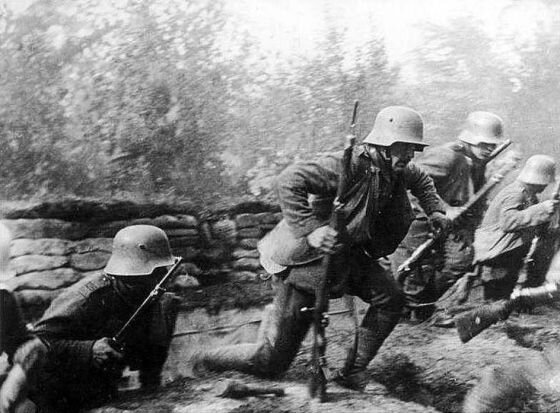By: Erika Schmitt
Stormtroopers. Hardly any other Star Wars character or creature can boast a name as synonymous with the franchise itself. According to Doug Chiang, vice president and executive creative director of Lucasfilm, these iconic anti-heros were originally meant to look like skeletons:
“The idea for that was that George wanted to create these sort of iconic images that looked like living skeletons and that’s why you have the stark black and white. So when you see the white armor coming out of a black room, you just see the armor and it’s a very, sort of, terrifying moment for you… One of the iconic things was that the helmet was very specific, it looks like a skull. It is a stylized skull. Ralph McQuarrie did a brilliant job to take all the key elements, like the eye sockets and the mouth, to make it, just sort of, a touch mechanical but yet still harken back to a living skull” (Wired).
However in Star Wars, this elite group are often portrayed as a laughing stock with their terrible aim, dull wits, and zero understanding of combat strategy which vastly contradicts the famous World War II sturmabteilung for which the group derives its name (Carlo). But just who were these German nationalists that inspired a cultural phenomenon?
Ralph McQuarrie’s pre-production artwork for Star Wars: A New Hope. Photo courtesy of Sideshow.
Stormtrooper Corps. Photo courtesy of Wookiepedia.
World War I
The idea of Stormtroopers originated in the trench stalemate of World War I. Both sides sought to break the defensive stalemate, whether by larger and larger masses of artillery and men, or by innovative technologies such as tanks or poison gas. By 1916, Germany no longer had the resources to compete in mass or technology; they instead had to fight smarter. They developed the tactic of having small, well-trained and well-equipped squads sneak across the no-man’s-land separating the sides, infiltrate the Allies’ trench network, and clear a section of the defenses by surprise, creating chaos in the enemy lines. These soldiers were called the sturmmann (storm man or stormtrooper) who were a part of larger sturmtruppe (assault troops or storm troops) companies. A surge of conventional troops could then pour through the temporary opening created by the sturmtruppe and destroy vulnerable command posts and logistics nodes kept behind the front lines before the enemy could even begin to orient themselves to the new threat. Such tactics were so effective that the Allies quickly adopted them as well, though not nearly to the same efficacy. While such tactics were not enough to save the German war effort, their effectiveness was long remembered by both sides, and quickly became standard infantry doctrine in the inter-war period. (“Stormtroopers-Imperial Germany”).
German Stormtroopers on the Western Front. Photo courtesy of Military History Now.
World War II
Freikorps or paramilitary groups are organized military-like forces that are loyal to a political party or private organization instead of a government; these groups were very common amongst World War I veterans, especially those that targeted communists, and by 1921 around 400,000 men were involved with paramilitary groups (“Storm Troopers,” Holocaust). One of these groups, from Bavaria, were known as the Turn-und Sportabteilung, or Sport and Gymnastic Division, who would eventually become the Sturmabteilung also known as the SA or stormtroopers (Holocaust). The SA were well known for their ruthlessness as well as their monochromatic uniform consisting of a brown top, brown pants, brown belt, brown combat boots, and brown cap. This look garnered the SA the nickname the “Brownshirts” (Rank). By 1923, Hermann Goring was made leader of the SA and their primary roles were Hitler’s security detail, enforcing Hitler’s orders, and preventing opposition by any means necessary. On 9 November 1923 one of the first SA functions, the Munich Beer Hall putsch, resulted in a failed attempt to overthrow the Bavarian government. The consequences of the failure earned Hitler a sentence of five years in jail (he served nine months), the banning of all Nazi organizations, Goring exiled, and the formal dissolution of the SA (Holocaust).
The SA in Nuremberg, 1929. Photo courtesy of Wikipedia.
By evading imprisonment and banishment, former Bavarian Army Captain and one of the first Nazi supporters, Ernst Rohm was able to continue to recruit and organize a paramilitary group in the former shadow of the SA, now renamed Frontbann (Holocaust). However, once Hitler was freed in 1924, Rohm wanted the 30,000 strong Frontbann to be integrated with the SA. Hitler refused, which led to Rohm’s resignation (“Sturmabteilung”). For the remainder of the 1920’s, the SA were a disorganized group more famous for street brawls with communist groups than anything else. It was not until 1931, when Rohm was asked to come back, that the SA grew exponentially (“Sturmabteilung”). Within ten months of assuming the role of the SA’s Chief of Staff, Rohm was responsible for recruiting 144,000 new members to bring the group total to 221,000. When Hitler was appointed Chancellor in 1933, the SA embraced violence and openly shot communists in the streets as well as beating social democrats to death in their offices; their power was above the law. Within a year, the SA would grow to 4 million members (Holocaust). Once considered an extremist fringe group, the SA had become the largest political party in Germany (“Sturmabteilung”).
Vastly outnumbering the German Army of 100,000 soldiers, Rohm demanded to combine the SA with the German military and take command of the military forces (Rank). This demand, coupled with the defiant and rebellious culture of the SA and outrage from German Army officials, marked the end for the SA. A dossier was compiled with fraudulent evidence that suggested Rohm had conspired with the French to overthrow Hitler, lies that Hitler, initially, refused to support. Despite respecting Rohm as one of his first supporters, Hitler ultimately believed that Rohm would eventually betray him (“Sturmabteilung”). On 30 June 1934, Hitler ordered the arrest of Rohm and 200 senior SA officials and over the next 48 hours had them executed - the exact number of SA officials is unknown but it is estimated that 150 to 200 of them were murdered (Rank, “Sturmabteilung”). The day would be known as ‘The Night of Long Knives.’ After the purge, the SA would never reach the numbers it once boasted and the group lost all independence. This downsizing allowed the Schutzstaffel or SS to assume the role of policing and security efforts. The SA offically ceased to exist with the collapse of Nazi Germany in May of 1945 (Holocaust).
Although there are many versions of troopers, the Imperial Stormtrooper was very much like the sturmmann. When audiences first see Imperial Stormtroopers in Star Wars: A New Hope, the Tantive IV has just been taken captive by Darth Vader and the crew prepares for boarding. Stormtroopers breach the vessel and clear out its defenders so Lord Vader can board, just like the sturmmann destroyed Allied trench systems in France. Both the Stormtroopers of World War I and Star Wars were chosen for being the best of the best. The comparisons do not end there, though. Imperial Stormtroopers were in many ways Darth Vader’s enforcers (just ask Uncle Owen and Aunt Beru), similar to the SA acting in support of the Nazis in 1930s Germany. The 501st Legion, the most famous of all stormtrooper units, is even known as “Vader’s Fist,” an important nickname that demonstrates their loyalty to the Empire, their lethality, and elite status.* Finally, with Hitler growing ever more suspicious of Rohm, he could no longer ignore Rohm’s bid for power - despite Rohm being one of his earliest supporters - and had him executed. Palpatine’s unscrupulous manner in which he disposes of former allies, such as Darth Maul, Count Dooku, and to some extent Darth Vader too, are eerily similar. With friends like these, who needs enemies?
*Important note: The 501st Legion, the international fan-based organization, is a tremendous costuming group that promotes philanthropy while also encouraging camaraderie and inclusion within the Star Wars Universe. The group is in no way affiliated with Nazi ideals, extremism, or violence, and this article in no way means to imply that. This article discusses only the in-universe military unit, whose military record speaks for itself. #TheEmpireDidNothingWrong
Sources
Carlo, Tori (2020). “The Mandalorian: How Did the Stormtroopers Suddenly Get So… Good?” Comic Book Resources. Accessed 15 December 2020.
https://www.cbr.com/why-mandalorian-stormtroopers-good-marksmen-fighters/
The Holocaust Encylopedia. “The SA.” United States Holocaust Memorial Museum. Accessed 15 December 2020. https://encyclopedia.ushmm.org/content/en/article/the-sa
Rank, Scott Michael. “Nazi Germany - Stormtroopers Sturm Abteilung SA.” History on the Net. Accessed 15 December 2020.
https://www.historyonthenet.com/nazi-germany-stormtroopers-sturm-abteilung-sa#:~:text=On% 204th%20November%201921%20the,(Stormtroopers)%20abbreviated%20to%20SA.
“Storm Troopers, Elite Guards, and Secret Police.” Facing History and Ourselves. Accessed 15 December 2020.
https://www.facinghistory.org/holocaust-and-human-behavior/chapter-5/storm-troopers-elite-gua rds-secret-police
“Stormtroopers - Imperial Germany.” Wikipedia. Accessed 15 December 2020. https://en.wikipedia.org/wiki/Stormtroopers_(Imperial_Germany)#Ottoman_stormtroopers
“Sturmabteilung.” Wikipedia. Accessed 15 December 2020.
https://en.wikipedia.org/wiki/Sturmabteilung
Wired (2019). “Every Stormtrooper in Star Wars Explained by Lucasfilm.” Youtube. Accessed 15 December 2020.
https://www.youtube.com/watch?v=m4LFX-RWfn4&list=PLLkoWjQ3H3dVR8IqKPkuztZ7D5 euJupSG&index=6




